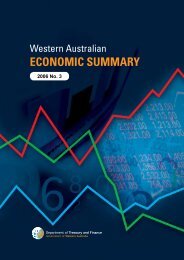2012-13 Government Mid-year Financial Projections Statement
2012-13 Government Mid-year Financial Projections Statement
2012-13 Government Mid-year Financial Projections Statement
- No tags were found...
You also want an ePaper? Increase the reach of your titles
YUMPU automatically turns print PDFs into web optimized ePapers that Google loves.
<strong>2012</strong>-<strong>13</strong> <strong>Government</strong> <strong>Mid</strong>-<strong>year</strong> <strong>Financial</strong> <strong>Projections</strong> <strong>Statement</strong>redeployment of staff from the OSS to line agencies.This mid-<strong>year</strong> review includes additional funding of $30 million over the forwardestimates period to assist agencies with the decommissioning process.Funding for SchoolsIn February <strong>2012</strong>, the Commonwealth <strong>Government</strong> released the final report of the Reviewof Funding for Schooling (also known as the ‘Gonski review’). The Commonwealthintroduced legislation regarding Australian school funding in November <strong>2012</strong>, but thelegislation did not contain any financial implications or a funding model. Therefore, thefuture impact on both government and non-government primary and secondary schoolfunding, and on State finances more broadly, cannot be quantified at this time.As a result of uncertainty with Commonwealth funding relationships, it is also notpossible to accurately forecast the full financial impact of the transition of Year 7 studentsto secondary settings in Western Australian government schools in 2015. Some recurrentexpenditure that is required prior to 2015, such as retraining of primary school teachers,was approved in the <strong>2012</strong>-<strong>13</strong> Budget process, but other recurrent expenses, such asteacher costs, were deferred to the 2014-15 Budget process when greater certainty aboutthe funding model will be available. The <strong>2012</strong>-<strong>13</strong> Budget included total funding(both recurrent and capital) of $341 million to progress implementation of this key<strong>Government</strong> initiative.Student Enrolment GrowthStudent enrolment growth in government schools of more than 3% in <strong>2012</strong> wassignificant, compared to total growth of 3.8% over the five <strong>year</strong>s from 2007 to 2011,with much of the growth driven by increased international and interstate migration.Funding for additional enrolment growth in 20<strong>13</strong> has been provided in this mid-<strong>year</strong>review, however if a repeat of <strong>2012</strong>’s significant growth occurs, funding will need to berevisited during the 20<strong>13</strong>-14 Budget process once the actual Semester 1 enrolments areknown.Skills ReformUnder the National Partnership Agreement on Skills Reform signed by theCommonwealth and States on <strong>13</strong> April <strong>2012</strong>, the State has committed to implementing(in 2014) an entitlement to a government subsidised training place to a minimum of aperson’s first Certificate III qualification (subject to State-based criteria). The entitlementwould be a student-centred and demand-driven approach to allocating skills trainingfunding. There is significant uncertainty over the demand for training under anentitlement model, which could put pressure on the State’s finances over the forwardestimates. The design of the entitlement model may need to incorporate measures tomanage demand, including adjusting the scope of the entitlement and the level ofcontribution that students make to the cost of training.38
















